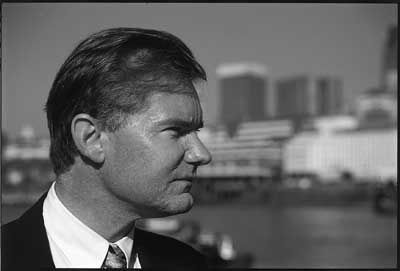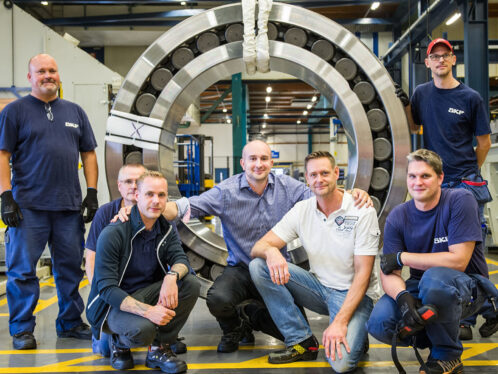Design to the heart of the matter
Ian Dryburgh sits in his London office, his back to the wide windows that let in a view of the historic Tower of London and Tower Bridge. Until the 1950s, this part of the Thames had an extraordinarily busy and vivid life based on London’s trade with the world. These days, the boats that pass up and down the river are mostly full of tourists, and the wharves that once held exotic fruits and spices now hold the rich and trendy.
Still, for a designer like Dryburgh, founder of the award–winning consultancy Design Acumen, proximity to a seaway like the Thames seems quite logical. At 16 he was the youngest winner of the Yachting World Design competition, a reflection not only on his design awareness but on his love of sailing. As Dryburgh admits, he has “messed about in boats” since he was 4 years old and has always owned a boat – until now. “I haven’t the time to sail at the moment,” he says regretfully. “I’ve bought a lovely 260–year–old house in Hampshire and it is a shambles, so I have been spending all my spare time renovating it. But sailing’s in my blood, so I can’t see myself giving it up completely. This is only a phase.”
A good student, in 1976 he went to Coventry Polytechnic to study on one of Britain’s first degree courses in industrial and transport design. “The course had everything in it that I wanted to do and that I had been playing around with ever since I was a child, without knowing what it was,” Dryburgh says. “What I discovered was that a formal education in industrial design is a disciplined approach to problem solving.”
Once out of college, he crossed the English Channel and went to Germany, where he became the first British person to be appointed to the Mercedes–Benz styling department. “It was fascinating to work in the country’s biggest company, in a factory of 38,000 people, and to be faced everywhere with their philosophy encapsulated in one motto all over the walls – ‘Best or nothing.’ The German pursuit of pure engineering excellence was very impressive,” Dryburgh says. “If you could combine the styling flair of Italians with the production skills of the Germans and the eccentric inventiveness of the British, you would have a potent amalgam of complementary skill sets.”
On leaving Mercedes–Benz in 1981, Dryburgh set up his own company, Design Acumen (DA), formerly part of Murdoch Associates, which DA Director Peter Murdoch founded in 1968. “In the beginning we had lots of little projects covering a wide range of industries, from telecommunications to engineering and architecture,” he says. “It gave us the experience to come up with relevant, commercial solutions that got to the heart of the matter and made the product successful.”
However, it wasn’t until the Design Acumen team designed the “flying bed” for British Airways that the company really took off. DA already had a strong base in transport design, reflecting Dryburgh’s love of the sea. The team has designed winches, windlasses and rope clutches for Lewmar Marine, the equipment supplier for the America’s Cup, and in 1996 it won the marine industry award for its blocks and pulleys range. But it was DA’s powerboats for Sunseeker International that caught the attention of British Airways.
It is generally recognised that it can be tough for product designers to feature in design competitions, but DA showed that it could be done. In 1996, its design for British Airways’ first–class seating took the prestigious Marketing Design Awards’ Gold Award for Design as well as being honoured in the category of Best Use of Design for New Industrial Product.
Working closely with the airline, the DA team examined the first–class environment from the traveller’s point of view and came up with a totally new concept: an armchair or even extra seat in a herring–bone–like layout that converts to a bed. A table, TV monitor screen and in–flight entertainment systems are housed in a sideboard rather than in the traditional in–seat location. The design increased the number of high flyers who chose British Airways and has had other airlines beating a path to Dryburgh’s door.
The opportunity to create such a revolutionary design is rare, Dryburgh says. “It created a new benchmark,” he says. “The cachet it brought us opened a lot of doors, and we are now working with aircraft manufacturers rather than just airlines.”
One spinoff from the British Airways contract was a contract for the interior design of the Fairchild Dornier 728JET – a 70–seat regional jet. The project took 13 weeks from drawing board to public launch at Farnborough Air Show and is unusual in that the entire interior and its components were designed as a single unit, not slapped in as piecemeal components from various suppliers.
There’s an airship project in the offing, and he hints at other projects in the aerospace industry.
Dryburgh runs a tight ship, with no more than 25 employees. “You don’t have to be big to be beautiful,” he says. “It has never been our intent to be the biggest design company in the world. The world of design was shocked when we came into prominence with British Airways, but the truth is we were in existence for 15 years before that and doing well, but not shouting about it.”
DA is not confined to the transport industry. The consultancy has designed a modular playground system, the Scuba Ski accessory for Action Man toy figure as well as laboratory instruments. It recently won an international design competition to produce a range of street furniture for Giraudy in France, and has also patented its own safety syringe.
Dryburgh waves his arm around the office, pointing out the DA–designed door handle, wall–partitioning system and a Hille office chair designed by DA director Murdoch. “What we do here is profound,” Dryburgh says with relish. “We’re not just beauty boys. We start from scratch and take an empirical approach. As a result, our products have longevity. It’s all about changing people’s perceptions of what is possible.”
Christine Aziz
a journalist based in London
photos John Cole




